

Homemade Glue Recipe. During their childhood, kids use a large amount of glue.
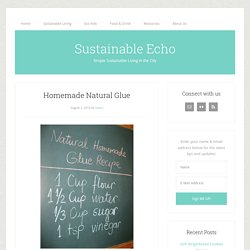
Most of them are chemical mixtures with no ingredients listed on the packaging. You can only imagine what’s in there. Preschoolers love pasting and collage, as well as tasting anything that comes close to their mouths. Besides the awful taste, shop bought glue might not be the perfect substance for their tummies. School kids have (hopefully) learned not to lick the glue, but having it on their skin and, occasionally, all over them, isn’t good either as we know that our skin absorbs anything that’s put on it. Whether you would like to avoid a chance of your kids digesting chemical glues, make your house greener and as chemical free as possible or just want to avoid buying stuff and reducing wasteful packaging, the recipe above is a sure winner. How to make non toxic homemade glue This glue will keep for a few days. Vinegar in this glue recipe acts as a mild natural preservative. P.S. Similar Posts: Building an Impedance Tube for measing absorption coefficients.
If you had read my previous thread on coming up with a research project on acoustics, this a kind of follow on from it.

I have spoken to the academic who I'll be working with and he came up with the suggestion for me to design and build a device for measuring sound absorption coefficients - something like the impedance tube. The impedance tube is a long tube with a speaker at one end and the test specimen at the other end. Standing waves are formed when a single frequency is passed through the tube. Using an SPL meter we can find the maximum and minimum pressures in the standing wave and with some calculations, determine a reflection coefficient. Works well for low frequencies where the wavelength is much larger than the diameter of the tube. So, not sure what I will be measuring yet, reflection coefficients, absorption, or transmition through a material.
So, the idea is for a quick measurement of materials with hopefully pretty accurate results. View forum - II. TREATMENT. Wooden sound diffusers (Do these actually work) Quote: Originally Posted by dknightd.
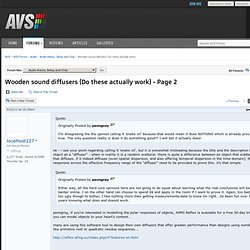
DIY Sound Diffusers—Free Blueprints—Slim, Optimized DIY Diffuser Designs (+Fractals) Quote: Originally Posted by I am somewhat interested in this simple to build optimized diffuser, but unconvinced.
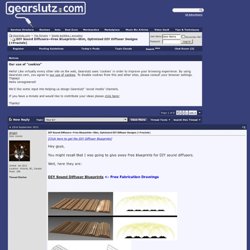
Homemade Reflection Filter (With Audio Examples) Photo by lrargerich In the recent shoot-out I did between the Shure SM7B and SM58, I discussed some of the reasons why you would use a dynamic microphone for lead vocals as opposed to a condenser.

One of the main reasons is that dynamics tend to pick up less of your room, so if you have a noisy room or just an acoustically bad-sounding room, a dynamic microphone might allow you to still record a decent vocal. That said, sometimes a condenser microphone simply sounds better. The next obvious step would be to do everything you can to minimize the amount of room the microphone picks up. The first thing people usually try is to throw the vocalist and microphone into a nearby closet. Eh…this will usually introduce more problems than solutions. How to Build Your Own Acoustic Panels (DIY) How to Build Your Own Acoustic Panels (DIY) Last Updated on Sunday, 10 November 2013 12:40 Written by AcousticsFREQ Thursday, 13 October 2011 08:41 Make Cheap, Easy, Attractive DIY Sound Absorption Wall Panels Also Check out our Complete Guide to Home Theater Acoustics for more information, including where to place your acoustic panels.
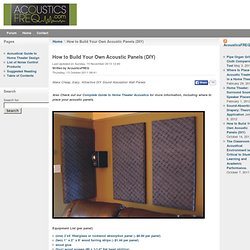
Sound absorption panels trap acoustical energy (sound) and prevent it from reflecting off of the surfaces they cover. The panels are used to eliminate echoes and reflections that muddle or color amplified music and speech. *Note that choral music, piano, orchestral instruments, group singing, and pipe organ benefit from reasonably reverberant acoustics, with many reflective surfaces. Suitable applications for sound absorption panels include: Note that sound absorption material is often called “soundproofing.”
HiFi Speaker Design © mhSoft <%=year(now())%> Quadratic residue diffusers (QRD) belong to the so-called pseudo stochastic diffusers.
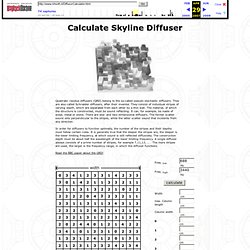
They are also called Schroeder diffusers, after their inventor. They consist of individual stripes of varying depth, which are separated from each other by a thin wall. The material, of which the structure is constructed, must be sound reflecting. Making acoustic panels tutorial « Audio Geek Zine. Apartment buildings are not the ideal place to have a home studio, the main problem with them is the acoustics are terrible.

My ‘studio’ has painted concrete walls, huge windows across one side, and is a L shape. This results in a very uneven frequency response, and ridiculous flutter echo. For not a lot of money I made a big improvement to this situation. Rigid fiberglass is the most cost effective way to acoustically treat a room. Foam only really makes a difference with mid and high frequencies, the panels I made are effective down to about 125 Hz according to the specs of the material.
Click any photo to enlarge. Polystyrene insulation as a sound insulation. Quote: Originally Posted by PhilE In a way this is why I checked- This guy is happy to do my rockwool work at the back and sides of the room but he didn't feel it was necessary for the front and roof (where the acoustic is less concern than leeking) Without seeing details of the room, I can't comment on whether the front and roof should be treated as substantially.

If there's a room above, or even to the side that you're trying to isolate yourself from, I'd recommend treating the roof the same as the walls.